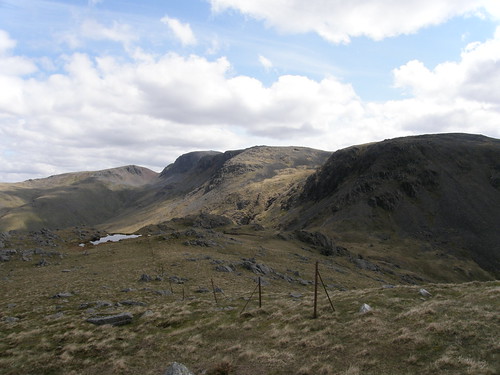45. Find your way with a map and compass
A and B seem to have caught the orienteering bug. We’ve been a few times now. Just this month, B and I tried the National Trust’s new course on Sizergh Fell with his Beaver Scout unit. Then both A and B went for a training session in Eaves Wood with a friend who knows about these things. So when we discovered that there would be an event not too far away at High Dam, above Windermere, we were keen to have a go.
Well, three of us were. TBH was under the weather and elected to stop at home. S just wanted to watch the telly. He moaned on the drive there. He moaned on the long walk to the start. But, fortunately, once we began he loved it.
A wanted to have a go on her own, the boys were content to have me tag along, although I let B do the map reading. We all did the white course (a short easy course with all controls lying along a route connected by paths). Both A and B missed the fact that they should have gone through the gate in the photo above, rather then continuing to follow the path we had been on up to that point. By the time we bumped into her, however, A had realised that she had made a mistake and was heading back to this control to have another go.
It was a relatively big event, there was food available at Finsthwaite House where the cars were parked in an adjacent field, and some of the kids friends were also there, so we stayed for quite some time after we had finished the route.
We might then have gone to take a tour around the nearby Stott Park Bobbin Mill which I remember fondly from a visit many years ago, but it was shut. So we went around the end of the lake to Fell Foot park instead.
The kids climbed and swang and were temporarily pirates on the extensive playground there whilst I supervised them carefully from a recumbent position. It was warm. The sun shone. How odd.
I must have been in some sort of shock – I forked out for both ice-creams and for a half-an-hour rowing-boat hire.
On the coping stones edging the lakeside path B spotted this large critter…
I think that it’s a stonefly, an adult female Perlodes microcephala. Stoneflies breed in water, in this case in stony streams. There are 34 British species.
And the post title? Well, it’s more Fun With Lists: the National Trust have a campaign to encourage kids to get outside and do…well the sort of stuff which is fun to do outside. I don’t like the idea of ‘Bucket Lists’, but I must admit that this one is quite fun. A went through the list and declared that she has 5 still to do. She has plenty of time.
Here’s the list in full:
- Climb a tree
- Roll down a really big hill
- Camp out in the wild
- Build a den
- Skim a stone
- Run around in the rain
- Fly a kite
- Catch a fish with a net
- Eat an apple straight from a tree
- Play conkers
- Throw some snow
- Hunt for treasure on the beach
- Make a mud pie
- Dam a stream
- Go sledging
- Bury someone in the sand
- Set up a snail race
- Balance on a fallen tree
- Swing on a rope swing
- Make a mud slide
- Eat blackberries growing in the wild
- Take a look inside a tree
- Visit an island
- Feel like you’re flying in the wind
- Make a grass trumpet
- Hunt for fossils and bones
- Watch the sun wake up
- Climb a huge hill
- Get behind a waterfall
- Feed a bird from your hand
- Hunt for bugs
- Find some frogspawn
- Catch a butterfly in a net
- Track wild animals
- Discover what’s in a pond
- Call an owl
- Check out the crazy creatures in a rock pool
- Bring up a butterfly
- Catch a crab
- Go on a nature walk at night
- Plant it, grow it, eat it
- Go wild swimming
- Go rafting
- Light a fire without matches
- Find your way with a map and compass
- Try bouldering
- Cook on a campfire
- Try abseiling
- Find a geocache
- Canoe down a river
The National Trusts website dedicated to the list is here:
But you have to sign up to access the entire list and then cope with the unedifying, but completely inevitable, hedging of bets as lots of unnecessary safety advice accompanies the list.
Not a bad list though. Any glaring omissions, do you think?















































































